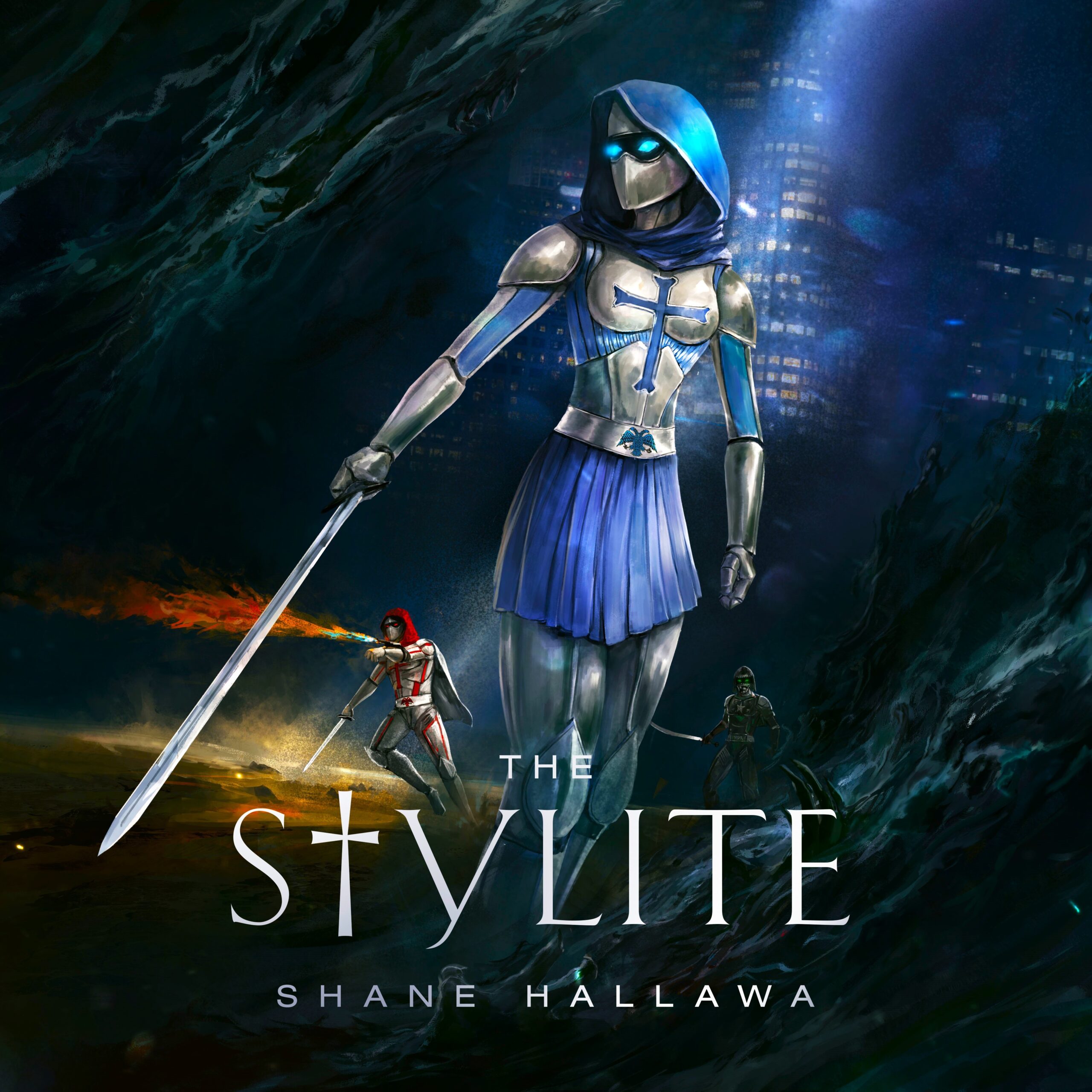Screenplay : The Stylite
Writer : Shane Hallawa
The Stylite, written by Shane Hallawa, is a captivating blend of spirituality, action, and supernatural intrigue. Adapted from his novel, the story follows Teresa Amadei, a young ascetic demon hunter trained in the Way of Fire, as she battles demons and navigates a chaotic world. Set against the backdrop of the Midwestern US, the screenplay delves into themes of faith, inner conflict, and the mystical forces that shape humanity. Hallawa’s unique storytelling, which fuses Byzantine mysticism, martial arts, and the supernatural, showcases his talent for weaving complex worlds and characters that linger long after the story ends.

Let’s dive into questions and savor the experiences you’ll be sharing on your journey:
1. The Stylite is adapted from your novel of the same name. What was the biggest challenge in translating your novel into a screenplay format?
The one challenge I experienced was the formatting itself, which I would consider a technical matter. Blocks of detail for the action scenes had to be altered from a general novel mode to directions or descriptions for a script.
2. The Stylite incorporates elements of fantasy, horror, and action. What draws you to this mix of genres, and how do you balance them in your storytelling?
Those genres in particular did not draw me in and of themselves, but the tokusatsu genre from Japan is a major influence on the stories I write. I believe this also ties into Question 8, so I will reference my answer to that below.
3. The Saracen, a black knight with his own agenda, adds a layer of mystery to the plot. What can you tell us about his role and how he complicates Teresa’s journey?
The Saracen is a parallel to the rise of Islam and the conquests of the Rashidun Caliphate across the Middle East and North Africa, battling the Byzantine and Sassanid Persian Empires along the way. Here, the Saracen represents an alternate answer for those seeking a solution to the spiritual and material decay of the Western world; his bold actions against criminals and the corrupt, without heed to any restraints, attracts a mass of followers to him. And so Teresa, who is still wrestling with her own mind and sense of self, feels her self-doubt egged on by the Saracen’s appeal; this in turn is used by Juliana to discourage her. The Cross and the Crescent circle each other while facing their common enemy, but both have the underlying feeling that the future will place them on opposing sides.
4. Demon hunting is often a metaphor for inner battles or societal issues. How do the Daemoklos represent both the literal and metaphorical challenges Teresa faces?
The Daemoklos are demons who have been released from their eponymous grimoire, which acts as a gate between the human world, or Earth, and their prison in a dimension of hell, the Daemokenó. The literal threat is apparent in how they physically terrorize, manipulate, and begin taking over human society under the directive of their god-king, Varazhah. But they also act as inner demons, or amplify the demons of one’s mind, encouraging ill and false thoughts, and exploiting emotions that are already there. Further still and interestingly, as Teresa, Matthew and the Saracen learn to see, we come to understand how even demons are products of the same thoughts, the same ego, the false self, as the humans they torment. In order to overcome the demons on her road, Teresa must learn to overcome herself; and in the process, she learns that a demon can possibly be swayed to (or back to) the Light as much as a human can.
5. How does The Stylite stand apart from other supernatural or demon-hunting stories out there? What themes or messages do you hope resonate most with your audience?
I wanted to write Teresa in a manner different from what has been “conventional” over the past several decades when it comes to female characters, especially in media targeted to younger people, namely in her relationship with her elders, and her “sibling bond” with Matthew. Often media wants to show these type of characters as “antagonistic to social norms” in general; and with regards to male siblings, the relationship is often portrayed in a “lopsided” way where the brother gets “discredited” in some way for some sort of “hypocrisy” that vindicates the sister’s views. Now Teresa has antagonism, particularly with her mother, but in a different way (or at least, a different style) than is often the case in media. The jibing between Teresa and Matthew is one part “normal sibling interaction,” but not at the expense of discrediting Matthew, the “elder brother,” as a character, which would ultimately have hurt his role in the story.
The dialogues and bantering between characters, good guys with good guys, heroes with villains, and even villains to each other, are all meant to express various themes and ideas that reflect many issues in the real world, especially cultural events in the West over the past thirty years. Yet at the same time, I tried to maintain a balancing act in weaving all these things in a way that doesn’t overshadow the story and characters to become a speech, but rather fits each character’s personality and motives.
6. Are there any plans for a sequel or further stories in the The Stylite universe? If so, where do you envision Teresa’s journey heading next?
I am already developing a sequel to The Stylite that will also be a crossover with another novel I am writing, called Zheng Taishi. The first part of the sequel will follow up on certain events in The Stylite, and how both Teresa and Matthew observe personal, local and world matters since their war with the Daemoklos. Namely, how people have reacted to them in different, and sometimes disheartening ways. The key this time is how Teresa can face the thoughts and feelings within her, and new situations threatening the world, now that she has been fully “born of spirit,” compared to where she was at the beginning of The Stylite.
7. Aside from The Stylite, are you working on any other screenplays or projects? What genres or themes are you excited to explore in the future?
I have released a new self-published novel on Amazon called “Akelarre Under The Sun,” which has also been converted into a spec script:
“US Air Force Captain Anthony Cavada is a veteran of the Archon War. On leave, Anthony goes to Puerto Rico on vacation to visit relatives. But a sailing trip with his sisters and cousin across the Caribbean becomes survival on the high seas as they come across the cargo ship Empecinado, which had mysteriously vanished without a trace. Tied to the Empecinado is the burgeoning mystic syndicate of the Brujaken, which itself is a subsidiary of a larger power in the Far East, the Kingdom of the Red Sun.”
Akelarre is tied to two other stories I wrote in the past but as of yet have not published and am working on revamping for the purpose. I intend to continue writing action stories, while also trying to adapt thriller and mystery elements as well.
8. Your writing blends historical, religious, and supernatural elements. How do you go about researching for such eclectic themes, and how do you maintain authenticity while building such diverse worlds?
The initial idea for “The Stylite” came back in the summer of 2014, while I was doing a graduate course. I was reading the book “In the Shadow of the Sword: The Birth of Islam and The Rise of the Global Arab Empire” by Tom Holland, which details the history of the Middle East and Mediterranean in Late Antiquity. The book went into detail on the Byzantine Empire, life in Constantinople (modern Istanbul) the stylites/Desert Fathers & Mothers, Christian monks/nuns who lived in seclusion in the dessert, and the Zoroastrianism of Sassanid Persia, namely their fire temples.
Reading all of that both indoors and outdoors in the summertime, one could feel immersed in the hot, dusty environments of that part of the world. From there came the first idea of a superhero-like character based on the stylites and the fire temples of Persia.
I first started with designing the armor suits that Teresa Amadei, her older cousin Matthew Abbate, and the Saracen wear. My first draft for the novel was started only in 2019; after taking a year break, it was finished around Eastertime of 2022. The rest of 2022 was spent getting the draft beta-read and creating second and final drafts, and compiling the series bible before finally publishing the script in 2023, and the actual book early in 2024.
9. As a storyteller, how do you approach character development, particularly in characters like Teresa and Matthew, who are so deeply connected to their spiritual and martial arts training?
The creation of Teresa Amadei as the protagonist is multifaceted. I’ve written stories in the past either starring male heroes or starring an ensemble male and female cast. So this time, for something different, I opted for a female protagonist. When it came to actually putting pen to paper to develop her, two of the main influences for both Teresa and her mother Juliana were “Barabbas” by Par Lagerkvist (and the 1961 movie adaptation starring Anthony Quinn), and “Miracle on 34th St.”
Juliana’s personality is comparable to Doris Walker’s in “Miracle,” not one who is inherently bad, but a woman who is “of the world” and advocates its norms because “that is what is considered right.” Barabbas as portrayed in the Bible has no real character, but Lagerkvist’s version portrays a duality of “cynicism or derision toward a higher moral order, in the face of reality,” and “innate awareness that things are not right in the world and himself, but unable to define it or commit to a side.” The relationship between Teresa and Juliana throughout the story exemplifies this conflict, with Teresa embodying the latter, and Juliana the former.
10. Finally, what advice would you give to aspiring screenwriters looking to adapt their own novels into screenplays?
Nothing particularly unique, beyond “write what you know,” make sure your characters and themes are readily understandable by readers/viewers, and submitting your work to as many events, festivals, etc. as possible or as befitting your work.
Thank you, Shane Hallawa, for taking the time to share your insights and creative process behind The Stylite. Your ability to blend spirituality, action, and the supernatural into a compelling narrative is truly remarkable. It was a pleasure exploring the rich world you’ve created and learning about your inspirations and future projects. We look forward to seeing where your storytelling journey takes you next, and we wish you continued success with your upcoming screenplays and endeavors!
Get Your Copy : https://www.amazon.com/Stylite-Shane-Hallawa/dp/B0CT9HY4HZ/ref=tmm_pap_swatch_0?_encoding=UTF8&qid=&sr=
Connect with the Writer : https://www.instagram.com/shanehallawa/
Got something to share? Reach out to us at [email protected].

